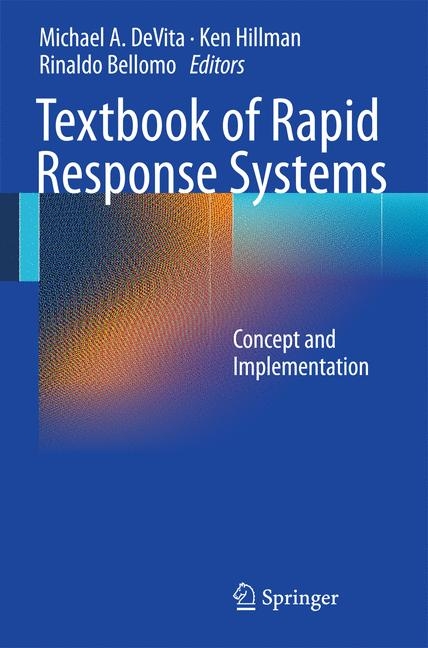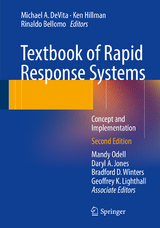Textbook of Rapid Response Systems
Springer-Verlag New York Inc.
978-0-387-92852-4 (ISBN)
- Titel erscheint in neuer Auflage
- Artikel merken
Successor to the editors' groundbreaking book on medical emergency teams, Textbook of Rapid Response Systems addresses the problem of patient safety and quality of care; the logistics of creating an RRS (resource allocation, process design, workflow, and training); the implementation of an RRS (organizational issues, challenges); and the evaluation of program results. Based on successful RRS models that have resulted in reduced in-hospital cardiac arrest and overall hospital death rates, this book is a practical guide for physicians, hospital administrators, and other healthcare professionals who wish to initiate an RRS program within their own institutions.
Michael A. DeVita, MD Professor, Critical Care Medicine University of Pittsburgh School of Medicine Department of Critical Medicine Pittsburgh, PA, USA Ken Hillman, MBBS, MD, FRCA (Eng), FCICM Professor of Intensive Care Director of the Simpson Centre for Health Systems Research The University of New South Wales The Australian Institute of Health Innovation The University of New South Wales Liverpool, Australia Rinaldo Bellomo, MD Chair, Australian and New Zealand Intensive Care Research Centre Professor, Faculty of Medicine, University of Melbourne Honorary Professor, Faculty of Medicine, Monash University Honorary Professor, Faculty of Medicine, The University of Sydney Honorary Principal Research Fellow, Howard Florey Institute, University of Melbourne Director of Intensive Care Research Staff Specialist in Intensive Care Department of Intensive Care Austin Hospital Melbourne, Australia
Section I: RRS’s and Patient Safety.- Rapid Response Systems History and Terminology.- RRS’s General Principles.- Measuring and Improving Safety.- Integrating a Rapid Response System into a Patient Safety Program.- Acute Hospitalist Medicine and the Rapid Response System.- Medical Trainees and Patient Safety.- Rapid Response Systems: A Review of the Evidence.- Health Care Systems and Their (Lack of) Integration.- Creating Process and Policy Change in Health Care.- The Challenge of Predicting in Hospital Cardiac Arrests and Deaths.- The Meaning of Vital Signs.- Matching Illness Severity with Level of Care.- Causes of Failure to Rescue.- Section II. Creating a RRS.- Impact of Hospital Size and Location on Feasibility of RRS.- Barriers to the Implementation of RRS.- An Overview of the Afferent Limb.- The Impact of Delayed RRS Activation.- The Case for Family Activation of the RRS.- RRT: Nurse-led RRS’s.- MET: Physician-led RRS’s.- Pediatric RRS’s.- Sepsis Response Team.- Other Efferent Limb Teams: (BAT, DAT, M, H, and trauma).- Other Efferent Limb Teams: Crisis Response for Obstetric Patients.- Personnel Resources for Responding Teams.- Equipment, Medications, and Supplies for a RRS.- The Administrative Limb.- The Secondary Victim.- Section III. Monitoring of Efficacy and New Challenges.- RRS’s in Teaching Hospitals.- The Nurse’s View of RRS’s.- Resident Training and RRS’s.- Optimizing RRS’s Through Simulation.- Evaluating Effectiveness of Complex System Interventions.- RRS Education for Ward Staff.- Standardized Process and Outcome Assessment Tool.- The Impact of RRS’s on Choosing “Not For Resuscitation” Status.- The Costs and the Savings.
| Zusatzinfo | 61 Tables, black and white; 44 Illustrations, black and white; XVIII, 438 p. 44 illus. |
|---|---|
| Verlagsort | New York, NY |
| Sprache | englisch |
| Maße | 156 x 234 mm |
| Gewicht | 1410 g |
| Themenwelt | Medizin / Pharmazie ► Medizinische Fachgebiete ► Anästhesie |
| Medizinische Fachgebiete ► Innere Medizin ► Kardiologie / Angiologie | |
| Medizin / Pharmazie ► Medizinische Fachgebiete ► Intensivmedizin | |
| Medizin / Pharmazie ► Medizinische Fachgebiete ► Notfallmedizin | |
| ISBN-10 | 0-387-92852-9 / 0387928529 |
| ISBN-13 | 978-0-387-92852-4 / 9780387928524 |
| Zustand | Neuware |
| Informationen gemäß Produktsicherheitsverordnung (GPSR) | |
| Haben Sie eine Frage zum Produkt? |
aus dem Bereich





